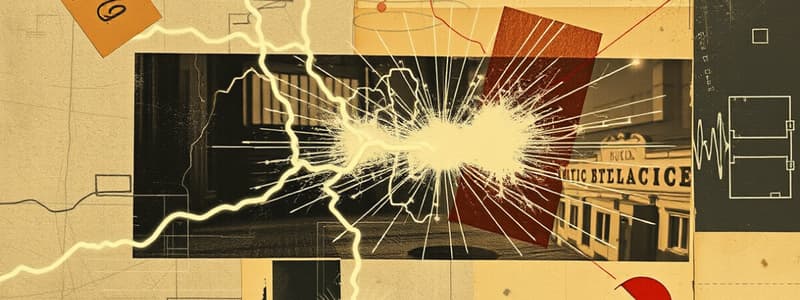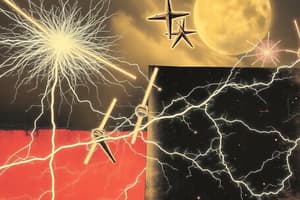Podcast
Questions and Answers
What is the first step in calculating the potential at point P?
What is the first step in calculating the potential at point P?
- Determine the electric field intensity at point P
- Calculate the total charge at point P
- Identify the charges affecting point P (correct)
- Measure the distance from point P to the surrounding charges
Which direction will the positive current flow if a metallic wire connects points B and D?
Which direction will the positive current flow if a metallic wire connects points B and D?
- From B to D (correct)
- From D to B
- There will be no current flow
- From point C to point D
How is the electric intensity at point B influenced by the surrounding charges?
How is the electric intensity at point B influenced by the surrounding charges?
- It remains constant regardless of nearby charges
- It only depends on the charge at point B
- It inversely correlates with the distance of the nearest charge
- It is affected by both the magnitude and distance of charges (correct)
What will happen to the electric field intensity at point P if an equal opposite charge is added at point B?
What will happen to the electric field intensity at point P if an equal opposite charge is added at point B?
What mathematical framework is used to determine whether work will be done moving a charge from point D to point P?
What mathematical framework is used to determine whether work will be done moving a charge from point D to point P?
In the triangle formed by points P, Q, and R, which mathematical relationship holds for the body hanging at point P?
In the triangle formed by points P, Q, and R, which mathematical relationship holds for the body hanging at point P?
What is necessary to calculate the electric field intensity at the center point P of the square formed by charges?
What is necessary to calculate the electric field intensity at the center point P of the square formed by charges?
What is the charge value placed at point C and how does it influence the electric field at point P?
What is the charge value placed at point C and how does it influence the electric field at point P?
What is the method to find the neutral point between the two charged spheres?
What is the method to find the neutral point between the two charged spheres?
If the two charged spheres with charges -2.25 nC and -6 nC are connected by a thin wire, what happens to the charges?
If the two charged spheres with charges -2.25 nC and -6 nC are connected by a thin wire, what happens to the charges?
What is the expected electric field intensity at point P if two charges +4 nC and +8 nC are at points A and B respectively?
What is the expected electric field intensity at point P if two charges +4 nC and +8 nC are at points A and B respectively?
If a charge is placed at point A in configuration shown, which way will it move?
If a charge is placed at point A in configuration shown, which way will it move?
In the described system, what happens to the direction of electron movement when a conductor is connected between points C and D?
In the described system, what happens to the direction of electron movement when a conductor is connected between points C and D?
Flashcards are hidden until you start studying
Study Notes
Static Electricity and Electric Field Intensity
-
Equilibrium at Point P: A q1 (1.5 × 10−9 C) and q2 (1.5 × 10−9 C) are placed in a right-angle triangle configuration with point P (1 kg) positioned. Calculate if the body will hang in equilibrium.
-
Electric Potential Calculation: Determining the potential at point P is essential for assessing the balance of charges in the given configuration.
Electric Intensity in Rectangular Field
-
Charges at Points A and C: Charge A is +1.5 × 10−3 C, and charge C is −2.5 × 10−3 C in a rectangular field (ABCD), with distances of 1.5m and 2m defining the layout.
-
Electric Intensity at Point B: Electric intensity at B needs calculation based on electric fields contributed by charges A and C.
-
Direction of Current Flow: Analyze the direction of positive current flow when connecting points B and D via metallic wire mathematically.
Square Configuration with Charges
-
Charges at Points A, B, C: There are charges q1 (2 × 10−9 C), q2 (3 × 10−9 C), and q3 (−4 × 10−9 C) arranged in a square.
-
Electric Field Intensity at Center P: Find the resultant electric field intensity at the center point P based on contributions from all charges.
-
Work Done Analysis: Evaluate whether work is done when moving a charge from point D to point P, considering field configurations.
Potential and Electric Field Change
-
Charges at Points A and B: Charges are +6 × 10−9 C (A) and +4 × 10−9 C (B) separated by 10cm, with point P located perpendicular to line AB.
-
Electric Potential at Point P: Determine the potential at point P due to the charges at A and B.
-
Field Intensity Change Analysis: Consider the effects on electric field intensity if a +4 × 10^9 C charge is placed at point B and compare with an equal opposite charge's placement.
Neutral Point Calculation Between Charged Spheres
-
Two Hollow Spheres: Charge Q1 = −2.25 nC and Q2 = −6 nC placed at distances r1 (15 cm) and r2 (25 cm) respectively.
-
Finding the Neutral Point: Calculate the neutral point on the line joining the two charged spheres based on their electric fields.
-
Charge Redistribution Analysis: Analyze the final charge distribution if the spheres are connected via a thin wire.
Electric Field Intensity in Circular Path
-
Charges at Points A and B: Charges q1 (4 nC at A) and q2 (8 nC at B) placed along a circular path. P is the center with a radius of 15 cm.
-
Electric Field Intensity at Point P: Calculate the intensity at the center P given the configuration of charges.
-
Electron Movement Direction: Determine the direction of free electron flow in the connected conductor between points C and D, utilizing mathematical justification.
Electric Potential and Charge Movement Direction
-
Charges at Points B and C: A charge of +9 nC (B) and -16 nC (C), with position D being determined in a configuration dividing line AD in a 2:1 ratio.
-
Electric Potential at Point D: Calculation of potential at point D from charges B and C is crucial.
-
Direction of Movement for Positive Charge at A: Analyze the movement direction of a unit positive charge placed at A considering the potentials established in the arrangement.
Studying That Suits You
Use AI to generate personalized quizzes and flashcards to suit your learning preferences.




